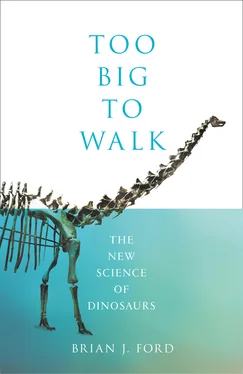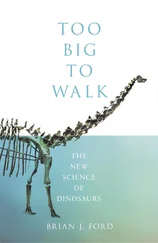1 ...6 7 8 10 11 12 ...29 Another important discovery was made in England in 1766 when an ichthyosaur jaw bearing teeth was discovered in strata at Weston, near Bath. It was exhibited as the bones of a crocodile by the Society for Promoting Natural History in 1783; meanwhile, more ichthyosaur fossils were included in the plates for a book by John Walcott published in 1779.30
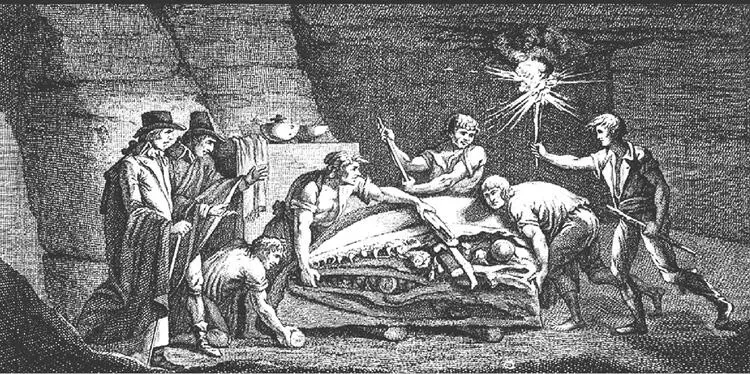
The huge skull of a mosasaur was excavated in St. Pietersberg, near Maastricht in the Netherlands, and was later given the name of Mosasaurus hoffmanni . This fanciful portrayal of the event was engraved in 1799 by G.R. Levillaire.
It was in 1764 that European scholars first encountered a dinosaur skull, though nobody realized its significance. This specimen had been dug out of a chalk mine by quarrymen at St Pietersberg, near Maastricht in the Netherlands, and took the form of fragments of jaws with rows of fearsome teeth which were assumed to be the remains of a crocodile. Two years later it was purchased from the miners as a curiosity by Lieutenant Jean Baptiste Drouin; Martinus van Marum, who had opened the Teylers Museum in Haarlem in 1784, subsequently acquired it as a highlight of the museum’s displays, and in 1790 he published a description of it as ‘a large fish skull’.31
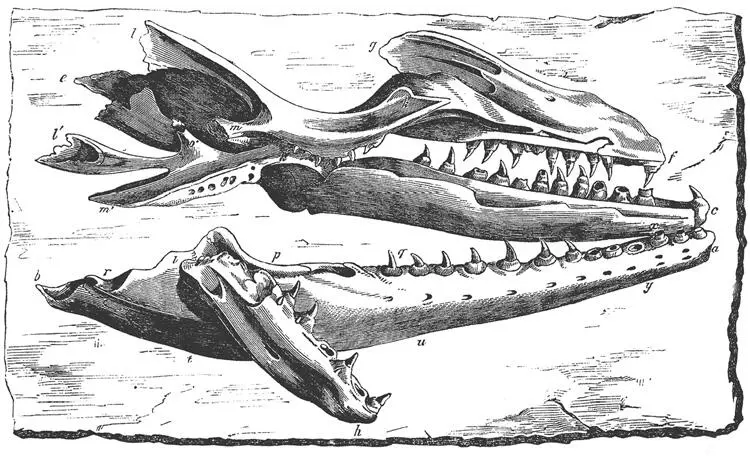
Pieter Harting published this engraving as the ‘Jaws of the Mosasaur’ in his book Album der Natuur in 1866. The original fossil was captured by the French in 1795 and taken to the Muséum National d’Histoire Naturelle in Paris, where it may still be found.
A second, similar, skull was excavated a few years later, on nearby land owned by Canon Theodorus Joannes Godding. He displayed it in his home as a curiosity until it was seen by a retired army doctor, Johann Leonard Hoffmann. Hoffmann was a keen fossil collector and decided this must be the skull of a crocodile. A friend of Hoffmann’s was the collector Drouin, and together they concurred that the remains were again those of a crocodile – or possibly a whale. French revolutionary forces under Napoleon occupied Maastricht in 1794, and this fossil was traded for 600 bottles of wine and taken as a trophy straight to Paris. Philosophers conventionally interpreted these petrified remains as coming from familiar creatures, and fossils were widely discussed by learned naturalists. Nobody imagined that fossils might be the remains of long-forgotten creatures, unknown to present-day scholarship, which had roamed the Earth in prehistoric times. It was assumed that the world then was much the same as the world of the past, though there was growing evidence that the Earth had changed over time. As long ago as 300 BC Aristotle’s young protégé Theophrastus had written a work entitled Peri Lithon (‘concerning stones’), which is the earliest work we know of that dealt with rocks. Theophrastus also noted that the draining of coastal swamps had rendered an entire area prone to freezing. He was also a pioneer of climate change, calculating that forest clearance resulted in warmer weather, because more heat could now reach the ground.32
The novel notion that the Earth could change over time was slowly emerging. A United Nations report quotes Vitruvius from around 50 BC, who recorded that many ancient settlements along the Anatolian peninsula in the Aegean Sea had been engulfed when changes in the landscape caused the sea to encroach. This is the first known record of major changes in the Earth’s surface. We now know that there are many ancient cities at the bottom of the sea – one in the Bay of Cambay, India, dates back 10,000 years, and there is another vast city on the bed of the Yucatán Channel near Cuba.33
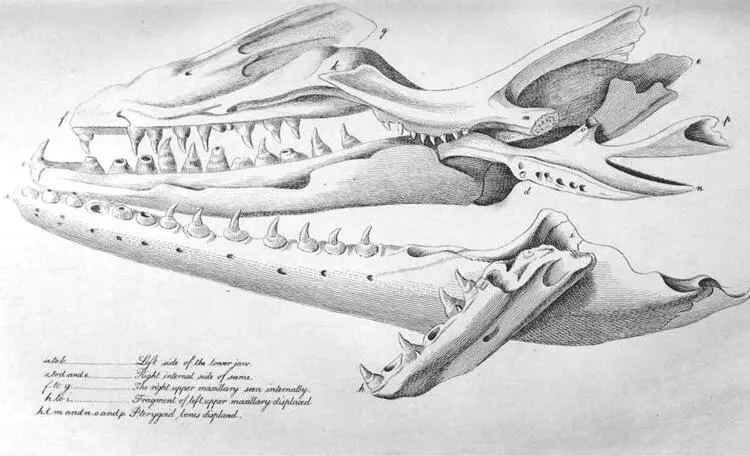
Georges Cuvier published this refined engraving as ‘The Mosasaurus of Maastricht, Huge skull found in a quarry at Fort St Peter near Maastricht, Netherlands, in 1780’ in his book The Animal Kingdom published in London by Whitaker & Co, 1830.
Another idea that was slowly emerging was that the prehistoric climate had also changed over time. The evidence first emerged from the remote villages of Switzerland, where the local people used to say that the gigantic boulders they found scattered along the valleys were signs that glaciers had once extended further down from the mountains. Pierre Martel, an engineer from Geneva, visited these villages in 1742 and later wrote about these stories. Perhaps the landscape and the climate had once been very different. At the time, this was an unpalatable prospect.34
At about the same time, a Swedish mining engineer, Daniel Tilas, was studying the erratic boulders in many of the Scandinavian countries and the nations bordering the Baltic Sea, and he similarly speculated that they were brought to their present positions by glaciers that had existed in the past.35
Matters were about to change with the revolutionary ideas of James Hutton, a Scottish farmer turned naturalist. Hutton had lectured on the structure of the Earth, and in 1785 he presented his findings in a lecture to the Royal Society of Edinburgh. He argued that many rocks were not original, primeval structures, but had been modified and subject to sedimentation and later to weathering. Hutton introduced a basic principle of modern geology, somewhat clumsily termed uniformitarianism, which states that the natural forces that we see operating on the landscape today are essentially the same as those operated in past æons. He concluded that the movement of rocks by prehistoric glaciers, like the progressive erosion of the coast, was the cause of the landscape around us. Geology was suddenly seen as relevant to the study of the present-day Earth.
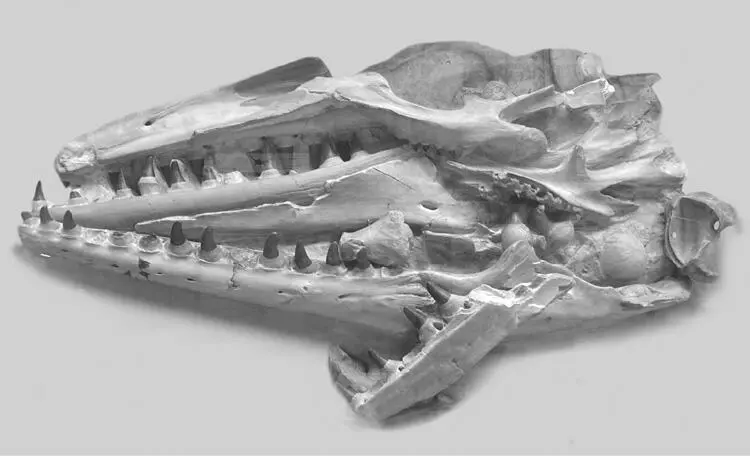
A replica of the original fossil from which the previous illustration was taken is on display in the Natural History Museum, London. The original specimen remains for the time being in the Muséum National d’Histoire Naturelle in Paris.
The term ‘geology’ had first been used by Ulisse Aldrovandi in his will of 1603, and came from the Greek γῆ ( gē , earth) and λoγία ( logia , study). Not until Hutton, however, was the subject given proper scrutiny and set on a firm scientific footing. Hutton used his principle of uniformitarianism to argue that many of the features of the present-day rocky landscape had begun at the bottom of the oceans, that many forms of rock had been produced by collections of ‘loose or incoherent materials’, and that these rocky layers were subject to rising, or falling, over the passage of immense periods of time. This was the first time anyone had put together the ideas fundamental to geology. In 1795, he finally published a book on his conclusions, and the new science of geology was firmly established.36
Several years after Hutton’s work, a Swiss hunter, Jean-Pierre Perraudin, decided to look further into the massive granite boulders that lay scattered around his home in the Alpine village of Lourtier. Perraudin was a professional hunter of chamois, the pretty mountain goats from which the finest leather is obtained. As he hiked across the mountains, he noticed two key facts: not only were there massive granite rocks scattered across the valley floor, but they were very different from the rocks nearby. They didn’t belong there. Secondly, he kept coming across deep longitudinal scratches and grooves carved into the valley sides. He sensibly concluded that this could mean only one thing – just as the villagers had always believed, glaciers had filled the valley in the past and had carried the boulders along, so it was these that had cut the deep grooves into the valley sides. Whenever an explanation for these curiosities had been sought in the past, philosophers said they were the evidence of the biblical flood, but Perraudin dismissed this as nonsense – he was certain that rising flood water could not move granite boulders. In 1815 he went to present his reasoned conclusions to Jean de Charpentier, born in Saxony and an enthusiast for geology, but Charpentier dismissed the idea as absurd. Undeterred, Perraudin raised the matter with a visiting engineer Ignaz Venetz, who lived in the nearby Rhône Valley, and the evidence he presented was so convincing that Venetz himself approached Charpentier and finally convinced him that the theory was right.37
Читать дальше
